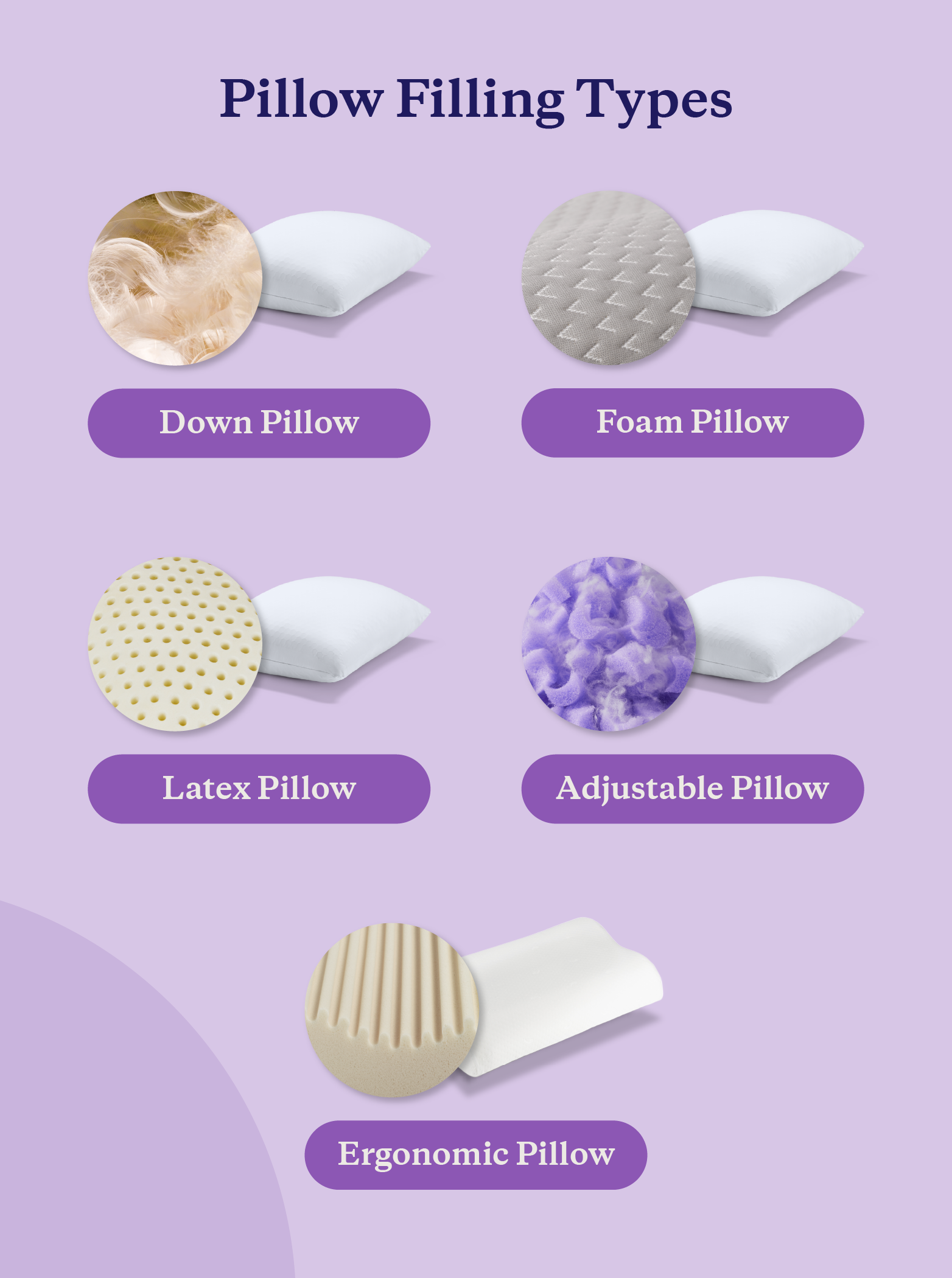
5 Types of Pillows for Every Sleep Style
Most people go years thinking they're getting the best sleep they can. But more often than not, the types of pillows and mattresses they use don't suit their sleep style.
Restless sleep often goes unnoticed because, over time, you can get used to lower-quality rest. Bad night(s) of sleep frequently get chalked up to a long day or general restlessness, when in reality, it’s because you’re sleeping on the wrong type of pillow or mattress.
Different pillow types have different purposes, and they vary based on firmness, size, softness, and materials —making it a bit of a challenge to choose the right pillow. In this article, we’ll break down the pros and cons of each type, as well as the features that can change the way you sleep in a big way.
1. Down and Down Alternative
Down pillows are filled with the soft, fine layer found beneath the outer feathers of waterfowl like ducks and geese. When used as filling, down creates a light and airy feeling with unparalleled softness and insulation. Down Alternative is the synthetic variant of down that provides the same comfort and feel while also being hypoallergenic. Keep in mind that down and feather are two entirely different types of materials despite the similarities.
| Pros | Cons |
| Softness | Regular fluffing required |
| Insulation | Prone to clumping and moisture retention |
| Hypoallergenic (down alternative) | Non-hypoallergenic (down & feather) |
Down
Down doesn't have those rigid quills in the middle that feathers do, which makes it slightly more malleable and conforming. That said, there are differences depending on which bird down is used.
- Goose down: Goose down is generally a higher-quality material. Since geese are bigger in size and their feathers are more insulating, pillows filled with this type of down are often extremely lofty.
- Duck down: Pillows made out of duck down are more common. Since ducks are smaller than geese, they're typically less insulating. This type offers a good balance between comfort and affordability.
- All down: "All down" means the filling is strictly made of down, be it from the same bird or a mix. That purity translates into a light and airy feel. They're usually more expensive than other options but their softness is worth the investment.
- Mixed down: Mixed down pillows are made of down and feathers. The feathers, quills included, come from different parts of the bird and affect the overall feel. They're less expensive and still offer good comfort and loft.
Feathers
Feather pillows are filled with the outer feathers of ducks or geese, adding a certain level of rigidity unlike down.
While it still offers great support, softness, and loft – the quills at the center of the feathers can often be felt through the pillow covering.
Feather pillows are less expensive than down, however, making them a comfortable, budget-friendly option.
Down Alternative
A down alternative pillow is a synthetic alternative that doesn't use animal feathers. Instead of real down, cotton and polyester microfibers replicate the same light and airy feeling. The Purple Cloud® and TwinCloud® Pillows, for example, are down alternative options made with hypoallergenic, ultra-fine gel fibers that won't trap heat, clump, or flatten with use.
- Cotton: Cotton fibers create a fluffy and supportive feel. It's hypoallergenic, breathable, moisture-wicking, provides good airflow, and is generally firmer than down pillows.
- Polyester: Synthetic polyester microfibers make up the filling, replicating the trademark softness of down. They often have a silky-smooth texture and are resilient over time.
2. Foam
Foam pillows stand out in terms of support and resilience. They excel at contouring to the shape of your head and neck, and you almost melt into them.
The foam generally has a slow rebound, maintaining its firmness and shape over time while providing exceptional support and consistent softness. One drawback of foam is its heat retention, something that might not be ideal for everyone's sleep style — in other words, if you tend to sleep hot.
| Pros | Cons |
| Pressure relief | Heat retention (memory foam) |
| Exceptional support | Firmness and weight |
| Heat dissipation (pneumatic foam) | Slow response to pressure |
Memory Foam
Memory foam pillows are filled with viscoelastic foam, which softens when it comes into contact with body heat and molds itself to contour to the shape of your head and neck.
It's excellent for alleviating pressure points and reducing pain in the neck and shoulders. Memory foam pillows trap heat and have a slow response to pressure, meaning it takes a moment to return to their original shape when you change positions.
Poly Foam
Polyurethane foam, known as poly foam, is a more standard material. It provides a firmer level of support and a faster response time. It still retains heat, however, and is less conforming, meaning it provides consistent support but with less contouring to your specific shape.
Pneumatic Foam
Pneumatic foam, or air foam, is a material that uses air pockets within its structure, making it more soft and conforming while providing better breathability. It gently molds to the shape of your head and neck for exceptional pressure relief — without trapping heat.
Pneumatic foam is one of the very few foams that aren't temperature sensitive, meaning if you leave it in a cold room (or outside while camping, for example)n you're camping) it won't turn into a hard block of foam, unlike memory/poly foams.
3. Latex
Latex foam can be natural or synthetic. The natural variant is derived from rubber tree sap, making it an eco-friendly and hypoallergenic option. Synthetic latex is a manufactured alternative.
They're unique in their buoyant and floaty feel, their exceptional breathability, and airflow. Latex pillows are generally cooler than other options, reducing the chances of overheating at night.
Latex pillows have a natural resilience and bounce back to their original shape quickly —maintaining support for extended periods of time.
| Pros | Cons |
| Support and durability | Initial foam smell |
| Hypoallergenic | Limited contouring |
Talalay Latex
Talalay latex is a specific type of processed latex foam that's used in high-end mattresses and pillows due to its supportive and long-lasting characteristics. It's highly sought-after because it offers a comfortable sleeping surface while maintaining proper spinal alignment.
This type of latex is naturally hypoallergenic and resistant to dust mites, mold, mildew, and other allergens. Its breathability helps regulate temperatures and maintain good airflow.
Beyond that, Talalay latex pillows provide exceptional pressure point relief, ensuring long-term comfort and healthy sleeping habits. They also retain very little body heat, making them the most well-rounded type of pillow for all sleeping styles.
That's why we use Talalay latex in our Purple Harmony™ Pillow — the greatest pillow ever invented™ needs the best materials available. Also, check out the Purple Harmony™ Anywhere Pillow! Perfect for on-the-go moments or just lounging around at home.
Dunlop Latex
Dunlop is one of two main methods for producing latex foam, with the other being the Talalay process. These pillows are firmer and denser by comparison. Whereas Talalay latex pillows have a softer feel, the Dunlop variant provides a firmer sleeping surface.
Dunlop tends to be more affordable than its Talalay counterpart and at the expense of buoyancy, softness, and breathability.
4. Adjustable
As the name suggests, an adjustable pillow — also known as a shapeable pillow — allows you to alter its loft to better fit your specific comfort needs and body shape. Generally, it consists of an inner filling and an outer cover, which can be adapted in a few ways.
The outer cover is typically zippered and the inner filling is removable. The filling can be made from shredded latex, down or down alternative, shredded foams, or other materials.
Adding or removing filling is one way to customize the loft and firmness of the pillow to your liking. This is especially useful if you experience frequent changes in your sleep positions. Adjustable options are great pillows for back sleepers who benefit from low loft cushioning support to maintain neck alignment.
Adjustable pillows are designed for flexibility and versatility. They're easy to adjust and manipulate while you search for the sweet spot. The drawback is that you may need to spend a bit of time adjusting your pillow for your needs, and as the filling may shift or compress over time, multiple adjustments might be necessary.
| Pros | Cons |
| Customized comfort | Frequent adjustments |
| Adaptable for all sleep positions | Maintenance |
Shredded Foam
This type of adjustable pillow's filling contains shredded pieces of foam, usually memory foam or poly foam from recycled foam mattresses and foam blocks. It's designed to provide a balance between support and comfort, as well as the adaptability of adjustable pillows. It's soft and highly moldable but also retains heat.
Die Cut Foam
Die cut foam is cut into specific patterns and shapes depending on its use. Instead of using recycled foams, which may have impurities like glue in them, die cut foam is where they use a “cookie cutter” tool to create small shapes.
These small shapes provide a similar feeling to shredded foam but are made of premium material with fewer impurities. Shredded foam might have small bits that when adjusted can make it more of a mess.
Check out Purple’s infinitely customizable Freeform™ Pillow, with die cut MicroFlex™ Moon Foam that lets you craft the perfect pillow with little to no hassle while adjusting.
Buckwheat
Buckwheat is a type of grain. Its outer shell, or hull, is used in some adjustable pillows as filling. The hulls are lightweight and breathable. These characteristics make for a highly adjustable loft, conforming support, and a long-lasting pillow. However, air does not pass well through them, and they can feel hot. In addition, they maintain their shape well.
5. Ergonomic
Ergonomic pillows are designed for optimal support and comfort for the head, neck, and shoulders during sleep. They're engineered with certain shapes, contours, and materials that focus on proper spinal alignment and reducing pain and discomfort.
These pillows are often used to help with issues related to poor sleep posture, neck stiffness, back pain, and snoring. Products like cervical and contour pillows are examples of how specific ergonomic pillows address precise sleep issues.
| Pros | Cons |
| Improved sleep posture | Adaptation period |
| Pain alleviation | Sleep position restriction |
Wave Shape
As the name suggests, wave-shaped pillows have a distinct design that features an undulating contour. They're exceptionally useful for supporting the head and neck and accommodating the natural curve of the spine. Products like cervical and contour pillows provide targeted support that helps alleviate sleep discomfort, but they are only effective if the height and firmness specifically fit your shape.
Extra Shape
Extra shape refers to pillows with unique designs and shapes. This includes body pillows and wedge pillows, for example, which provide targeted support that caters to proper spine alignment, alleviates pain and discomfort, and helps mitigate poor sleeping habits.
Which Pillow Is Right for You?
While knowing what each type of pillow is designed for can be a great starting point, finding the right pillow for you depends on more than just your posture and sleeping position. You should also consider the following factors:
- Feel and Type: Some people can't sleep well if a pillow is too firm or too soft. Make sure your choice accounts for how it feels, first and foremost.
- Features: Consider what features are most important to you. Do you want a pillow that is adjustable that you can customize while your sleeping style evolves? Or are you seeking a pillow with great cooling benefits? Do you travel a lot? Are you looking for a pillow that would be great on a plane or in a hotel room?
- Pillow Height: Consider the pillow's height before you buy it.
- Low: Often preferred by stomach and back sleepers, people with small-to-medium frames who prefer a lower pillow height.
- Medium: Often preferred by side or combination sleepers, people with medium-to-large frames who prefer a medium-height pillow.
- Tall: Often preferred by side or combination sleepers, people with large to extra-large frames who prefer a taller pillow.
- Mattress Size: Understand that if you have a king-size mattress, you might want to look into getting a king-size pillow to complement it. Or if you have a queen or anything smaller you should look into getting a standard or queen-size pillow as it will be a better fit.
- Pillow Size: If it's too big or too small, the pillow could affect the quality of your sleep. Make sure you choose the right pillow size.
- Number of pillows: If you sleep with multiple pillows, look for options that align with your needs and preferred lofts to maintain healthy spinal alignment.
FAQ
Which Pillow Type Is Best for Sleeping?
There's no one-size-fits-all answer when it comes to pillows. Each person has their own sleep style and needs. When in doubt, compare your sleeping style (back sleeper, side sleeper, stomach sleeper) to your preferences (softness, firmness, adjustability) to narrow down your options.
What Type of Pillow Is Best for the Neck?
There are quite a few neck support pillow options that are designed for ideal comfort and alignment. Cervical pillows are specifically designed for this purpose and feature a contoured shape that matches the natural curvature of the neck. In some cases, a memory foam pillow can be a good match depending on your preferences.
Is a Firm or Soft Pillow Better?
Each type of pillow excels in a different way. Firm pillows are some of the best pillows for side sleepers and back sleepers because they provide more support and help maintain proper spinal alignment by keeping the head and neck from sinking too far into the pillow. Soft pillows, on the other hand, offer a smoother feel, which is ideal for those who want a more comfortable option — especially stomach sleepers.
How Often Should I Replace a Pillow?
Your pillow's lifecycle can range from six months to four years depending on its type, materials, and quality. For example, polyester or down alternatives should be changed every six months to two years, whereas latex pillows should only need to be changed every three to four years. How often you should replace your pillow ultimately depends on how frequently you notice lumping, neck pain, and other common signs of wear.
Improve Your Sleep With a New Pillow
A new pillow is one of the most underrated investments anyone can make to improve their sleep quality. More often than not, people don't realize how much better their sleep can be until they find the right pillow for their situation.
There are many comfortable bed pillows at Purple that can elevate your sleep and mitigate the physical and mental effects of poor sleep habits and incompatible bedding. Our selection offers top-tier comfort with a wide range of unique features, as well as all the pillowcases and accessories your bedroom needs. Learn more about our pillows with our Purple Pillow comparison guide.



